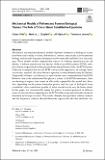Files in this item
Mechanical models of pattern and form in biological tissues : the role of stress-strain constitutive equations
Item metadata
| dc.contributor.author | Villa, Chiara | |
| dc.contributor.author | Chaplain, Mark A. J. | |
| dc.contributor.author | Gerisch, Alf | |
| dc.contributor.author | Lorenzi, Tommaso | |
| dc.date.accessioned | 2021-05-26T11:30:03Z | |
| dc.date.available | 2021-05-26T11:30:03Z | |
| dc.date.issued | 2021-05-26 | |
| dc.identifier | 274287410 | |
| dc.identifier | feb5fb3b-fffb-467b-9ef6-42d5fe885fde | |
| dc.identifier | 85106915537 | |
| dc.identifier | 000757423200004 | |
| dc.identifier.citation | Villa , C , Chaplain , M A J , Gerisch , A & Lorenzi , T 2021 , ' Mechanical models of pattern and form in biological tissues : the role of stress-strain constitutive equations ' , Bulletin of Mathematical Biology , vol. 83 , 80 . https://doi.org/10.1007/s11538-021-00912-5 | en |
| dc.identifier.issn | 0092-8240 | |
| dc.identifier.other | ORCID: /0000-0001-5727-2160/work/94669828 | |
| dc.identifier.uri | https://hdl.handle.net/10023/23254 | |
| dc.description | MAJC gratefully acknowledges the support of EPSRC Grant No. EP/S030875/1 (EPSRC SofTMech^MP Centre-to-Centre Award). | en |
| dc.description.abstract | Mechanical and mechanochemical models of pattern formation in biological tissues have been used to study a variety of biomedical systems, particularly in developmental biology, and describe the physical interactions between cells and their local surroundings. These models in their original form consist of a balance equation for the cell density, a balance equation for the density of the extracellular matrix (ECM), and a force-balance equation describing the mechanical equilibrium of the cell-ECM system. Under the assumption that the cell-ECM system can be regarded as an isotropic linear viscoelastic material, the force-balance equation is often defined using the Kelvin–Voigt model of linear viscoelasticity to represent the stress–strain relation of the ECM. However, due to the multifaceted bio-physical nature of the ECM constituents, there are rheological aspects that cannot be effectively captured by this model and, therefore, depending on the pattern formation process and the type of biological tissue considered, other constitutive models of linear viscoelasticity may be better suited. In this paper, we systematically assess the pattern formation potential of different stress–strain constitutive equations for the ECM within a mechanical model of pattern formation in biological tissues. The results obtained through linear stability analysis and the dispersion relations derived therefrom support the idea that fluid-like constitutive models, such as the Maxwell model and the Jeffrey model, have a pattern formation potential much higher than solid-like models, such as the Kelvin–Voigt model and the standard linear solid model. This is confirmed by the results of numerical simulations, which demonstrate that, all else being equal, spatial patterns emerge in the case where the Maxwell model is used to represent the stress–strain relation of the ECM, while no patterns are observed when the Kelvin–Voigt model is employed. Our findings suggest that further empirical work is required to acquire detailed quantitative information on the mechanical properties of components of the ECM in different biological tissues in order to furnish mechanical and mechanochemical models of pattern formation with stress–strain constitutive equations for the ECM that provide a more faithful representation of the underlying tissue rheology. | |
| dc.format.extent | 38 | |
| dc.format.extent | 2923863 | |
| dc.language.iso | eng | |
| dc.relation.ispartof | Bulletin of Mathematical Biology | en |
| dc.subject | Pattern formation | en |
| dc.subject | Mechanical models | en |
| dc.subject | Murray-Oster theory | en |
| dc.subject | Biological tissues | en |
| dc.subject | Stress-strain constitutive equations | en |
| dc.subject | Linear viscoelasticity | en |
| dc.subject | QA Mathematics | en |
| dc.subject | QH301 Biology | en |
| dc.subject | DAS | en |
| dc.subject.lcc | QA | en |
| dc.subject.lcc | QH301 | en |
| dc.title | Mechanical models of pattern and form in biological tissues : the role of stress-strain constitutive equations | en |
| dc.type | Journal article | en |
| dc.contributor.sponsor | EPSRC | en |
| dc.contributor.institution | University of St Andrews. Applied Mathematics | en |
| dc.contributor.institution | University of St Andrews. School of Mathematics and Statistics | en |
| dc.identifier.doi | https://doi.org/10.1007/s11538-021-00912-5 | |
| dc.description.status | Peer reviewed | en |
| dc.identifier.grantnumber | EP/S030875/1 | en |
This item appears in the following Collection(s)
Items in the St Andrews Research Repository are protected by copyright, with all rights reserved, unless otherwise indicated.

